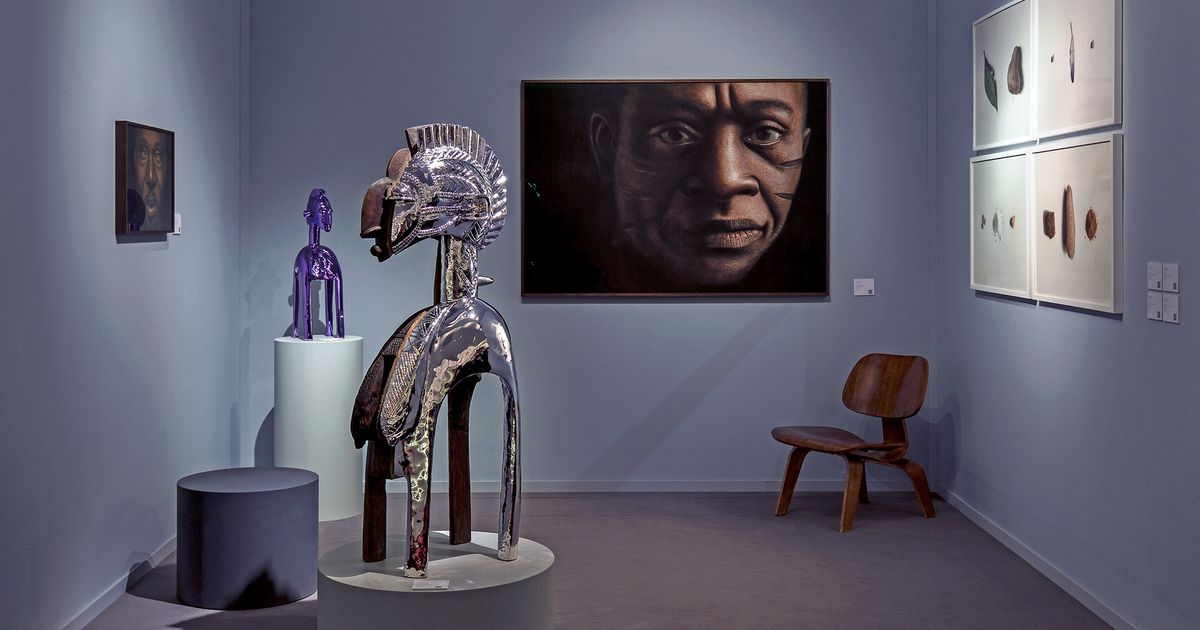
Tafeta Gallery has moved to Russell Square. Tafeta, which is taking part in London Gallery Weekend, is owned by Ayo Adeyinka, a gallerist of Nigerian heritage who is something of a unicorn. There are few Black-owned galleries in the UK and even fewer in the central London area.
Every once in a while, a ‘pop up’ will surface, giving us all a glimpse of what is possible. Bold, independent curators like Bolanle Tajudeen, Adeola Ayoola, Lisa Anderson and Maryam Lawal have been known to commandeer spaces in London and fill them with the work of Black artists. By doing so, they refuse to wait for permission from the so-called gatekeepers to display Black art. But a ‘pop up’ is by design temporary in nature. All too soon, the dates listed on the flyer come and go, the installations are taken down, the unsold canvases are rolled up, and we are left scouring social media for the next one.
So why are there so few Black-owned gallery spaces in London? This seems especially curious when you consider the fact that Black and African art is on the rise. Both Sotheby’s and Bonhams have a dedicated Modern and contemporary African art auction that frequently set records for emerging and established artists.
Over the past decade, we have celebrated the increasing visibility of Black artists. Recent names like Amoako Boafo, Cassi Namoda, Joy Labinjo, Jadé Fadojutimi and Nengi Omuku, have joined names like Njideka Akunyili Crosby, Toyin Ojih Odutola, Lynette Yiadom-Boakye and Oscar Murillo, who themselves have joined forerunners like Frank Bowling, Yinka Shonibare, Lubaina Himid, Sonia Boyce and Sokari Douglas Camp. There is a whole firmament of Black art stars and the galaxy is growing every day. So where are all the Black gallerists?
Wouldn’t it seem a little odd if the only person you trusted to explain Degas to you, had never set foot in France or if they had, hadn’t strayed very far from their hotel?
If you’re an appreciator or a collector of art, might I suggest that you’re asking the wrong question. Don’t turn outwards to the gallery landscape. Turn inwards to yourself. When was the last time you set foot in a Black-owned gallery? And when was the last time you bought art from a Black-owned gallery? Galleries are like other businesses. Try as they might to hide their grubby capitalist origins behind sepulchral white walls and transparent glass, it’s money that keeps the spotlights on, that pays the rent, that buys the sparkling water and prosecco (if you’re lucky) for the opening night.
Why don’t collectors trust the taste of Black gallerists when it comes to buying Black art? That elusive, undefinable quality known as ‘good taste’ is part of the reason collectors buy art from galleries. They trust the gallerist’s opinion that a particular artist is worth looking at, worth living with, worth investing in. Of course, a collector’s personal response to the piece is also part of the buying equation, but so is the reputation of the gallerist. Are they recognised as a taste maker? Does their name enhance an artist’s brand (an ugly word perhaps but a useful reminder that galleries are businesses)?
Now, I’m not saying that only Black gallerists and curators can sell or engage with the work of Black artists. This would be reductive. But wouldn’t it be curious if all the recognised authorities on post-war American abstract Expressionism were Nigerian? Wouldn’t it seem a little odd if the only person you trusted to explain Degas to you had never set foot in France or, if they had, hadn’t strayed very far from their hotel?
The way that Black artists are positioned in the European and American art markets can sometimes reveal that the people selling the art know very little about the culture that inspired the art. How many times have I read the pretty one-page print-out that is handed out at an African artist’s opening and wondered why the African masters who influenced their work are never mentioned? Instead, there is the attempt to shoe-horn these artists into a Western art canon, to speak of Monet before speaking of Uche Okeke and the Zaria Art Society. As if the only route to artistic pedigree is via the Western canon.
Or, even worse, there is the pretence that these artists have arrived on the Western scene without any artistic heritage or ancestry. They have been ‘discovered’ by the Western curator, sui generis, defying classification. ‘Africa always brings us something new,’ the publicity package for some of these exhibitions might read. Of course, African artists create work that is new and exciting but, like all artists, they innovate out of an existing tradition, they engage in dialogue with what has gone on before—either to extend it or to smash it to smithereens.
I will conclude where I began. Tafeta gallery has moved to its new location in Russell Square, just by the British Museum. Addis Fine Art, which champions Ethiopian artists, has a new base in South Kensington. If you believe that there should be more Black-owned galleries, in this age where talk about diversity is trumpeted but action remains thin, then pay these galleries a visit. If you like the art and can afford it, then buy it.
• Chibundu Onuzo is a Nigerian novelist and a fellow of the Royal Society of Literature
Source link : https://www.theartnewspaper.com/comment/why-are-there-so-few-black-owned-galleries-in-london












